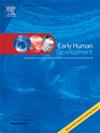Effect of sequential swallow training programme on feeding transition and suck-swallow-breath coordination in preterm infants
IF 2
3区 医学
Q2 OBSTETRICS & GYNECOLOGY
引用次数: 0
Abstract
Aims
To retrospectively evaluate the effect of a sequential swallow training programme (SSTP) consisting of nonnutritive sucking (NNS), modified feeding posture, oral sensory-motor intervention and breath exercise on the independent oral feeding transition and coordination of suck-swallow-breath (SSB) functions in preterm infants.
Methods
Sixty preterm infants received SSTP intervention and sixty infants receiving NNS were set as control. The feeding performance and SSB coordination were assessed using POFRAS and NOMAS scales.
Results
The transition interval were 8.42 ± 4.49 and 10.27 ± 5.05 days for SSTP and NNS group, respectively (P = 0.022). SSTP group had substantially more weight gains and shorter in-hospital stay than NNS. Two groups had comparable POFRAS and NOMAS scores before interventions, which were significantly increased after treatments in the two groups (P < 0.05). SSTP groups exhibited higher POFRAS scores, and better NOMAS performance reflected by the movement and coordination of jaw and tongue, especially in the normal sucking domain than the NNS group (P < 0.05). Both interventions significantly reduced the episodes of desaturation, apnea, and bradycardia, while no priority was shown for SSTP comparing with NNS. Multivariate linear regression analysis revealed that SSTP intervention was independently associated with decreased full oral feeding transition days, more weight gain during intervention and higher POFRAS score after intervention.
Conclusion
SSTP intervention shorten the transition days to full oral feeding and efficiently improved oral movement and coordination of SSB pattern when feeding.
顺序吞咽训练方案对早产儿进食过渡和吸吮-吞咽-呼吸协调的影响。
目的:回顾性评价由非营养性吸吮(NNS)、改良喂养姿势、口腔感觉运动干预和呼吸练习组成的顺序吞咽训练计划(SSTP)对早产儿独立口腔喂养过渡和吸吮-吞咽-呼吸(SSB)功能协调的影响。方法:60例接受SSTP干预的早产儿和60例接受NNS干预的早产儿作为对照。采用POFRAS和NOMAS量表评估摄食性能和SSB协调性。结果:SSTP组和NNS组的转换时间分别为8.42±4.49和10.27±5.05 d (P = 0.022)。与NNS组相比,SSTP组体重增加更多,住院时间更短。两组干预前POFRAS和NOMAS评分相当,治疗后两组POFRAS和NOMAS评分显著升高(P结论:SSTP干预缩短了向全口喂养过渡的时间,有效改善了喂养时口腔运动和SSB模式的协调性。
本文章由计算机程序翻译,如有差异,请以英文原文为准。
求助全文
约1分钟内获得全文
求助全文
来源期刊

Early human development
医学-妇产科学
CiteScore
4.40
自引率
4.00%
发文量
100
审稿时长
46 days
期刊介绍:
Established as an authoritative, highly cited voice on early human development, Early Human Development provides a unique opportunity for researchers and clinicians to bridge the communication gap between disciplines. Creating a forum for the productive exchange of ideas concerning early human growth and development, the journal publishes original research and clinical papers with particular emphasis on the continuum between fetal life and the perinatal period; aspects of postnatal growth influenced by early events; and the safeguarding of the quality of human survival.
The first comprehensive and interdisciplinary journal in this area of growing importance, Early Human Development offers pertinent contributions to the following subject areas:
Fetology; perinatology; pediatrics; growth and development; obstetrics; reproduction and fertility; epidemiology; behavioural sciences; nutrition and metabolism; teratology; neurology; brain biology; developmental psychology and screening.
 求助内容:
求助内容: 应助结果提醒方式:
应助结果提醒方式:


